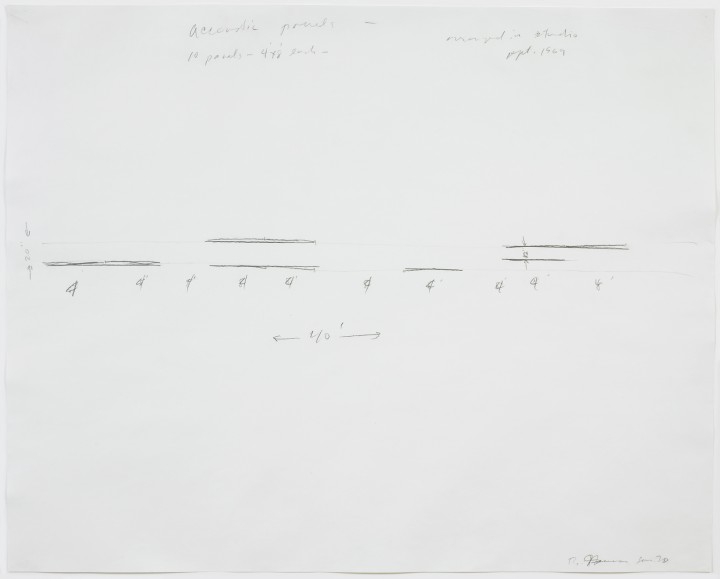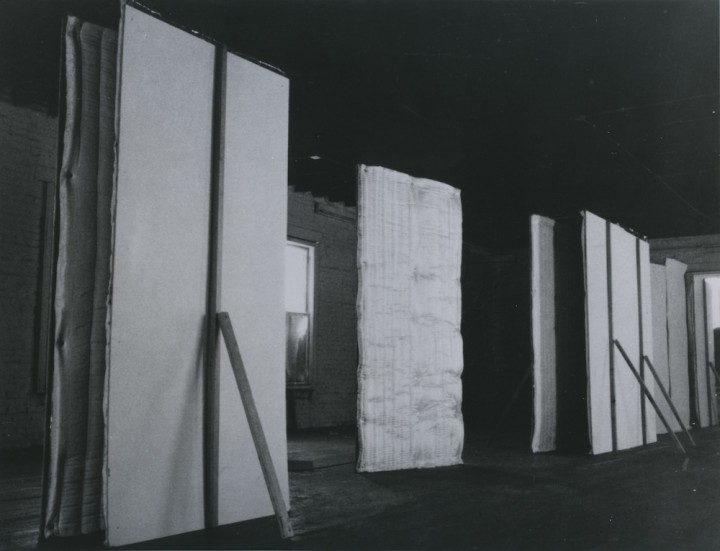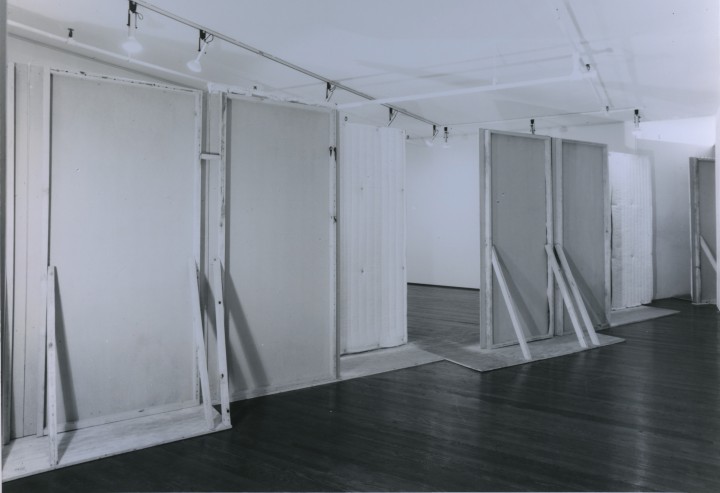Delia Solomons on Bruce Nauman

Figure 1. Bruce Nauman, acoustic panels / 10 panels – 4′ x 8′ each / arranged in studio / sept. 1969, 1970
Graphite on paper, 23 3/8 x 29 inches (59.4 x 73.7 cm)
© 2012 Bruce Nauman/ Artists Rights Society (ARS), New York
Bruce Nauman
by Delia Solomons
Bruce Nauman’s drawing acoustic panels / 10 panels—4′ x 8′ each / arranged in studio / sept. 1969 (1970; fig. 1) delineates a sculpture comprising ten upright panels staggered in parallel rows across a room. The bare, schematic drawing reflects a hasty informality. Mistakes are not erased or hidden—words are misspelled (“accoustic”), and Nauman casually jotted the accurate “4-foot” measurement over the incorrect “8-foot” notations. He also superimposed precise lines drawn with a straightedge upon his preliminary gestural lines. Such corrections offer insight into the artist’s visual thinking, specifically into his view of art as a creative process of trial and error rather than a resplendently crafted product of divine genius.
Despite the drawing’s rough, unfinished appearance, its large size suggests a presentation piece rather than a sketch made strictly for personal use. Nauman employed drawing to communicate his ideas to several audiences. Like many artists in the 1960s and 1970s, he often enlisted others to fabricate his works, and drawing served as a useful means of instruction. However, this drawing’s imprecise overall view and lack of structural details and information about materials render it of little use to someone trying to construct the panels. Furthermore, the text in the drawing itself reveals that it documents a sculpture that was already “arranged in studio—sept. 1969.” This sketch served to record a temporary installation, perhaps not only for the artist’s archives but also as a means to acquire a second venue. It may have been used in a successful pitch to Leo Castelli, as the staggered panels of Acoustic Pressure Piece occupied his New York gallery in 1971.

Figure 2. Bruce Nauman, Acoustic Pressure Piece, c. 1969
Installation at the artist’s studio, Pasadena, CA
© 2012 Bruce Nauman / Artists Rights Society (ARS), New York

Figure 3. Bruce Nauman, Acoustic Pressure Piece, 1971
Installation at the Castelli Gallery, New York
© 2012 Bruce Nauman / Artists Rights Society (ARS), New York
The drawing operates as an intermediary between the two installations, between the artist’s private studio (fig. 2) and the public gallery (figs. 3, 4).1 In the mid- to late 1960s the studio was central to Nauman’s practice, notably in sculptures that trace his body and films that chronicle his activities. The drawing Acoustic panels both documents an installation in his studio in Pasadena, California, and is itself a product of studio practice (sketching). However, the drawing also marks a shift away from these earlier projects and toward the corridors and sound installations that would preoccupy Nauman in the late 1960s and early 1970s. In these works he no longer recorded his own body or actions but instead created constrictive spaces in which the viewer-cum-participant becomes acutely aware of the body’s phenomenological relationship to its environment. Reflecting the artist’s turn to architectural scale, the drawing recalls an architectural plan with its bird’s-eye view, notations, and diagrammatic lines mapping wall-like panels. This simple graphite drawing cites and links the broad range of practices (sculpture, architecture, sound, and text) that Nauman employed at this crucial moment in his career.

Figure 4. Bruce Nauman, Acoustic Pressure Piece, 1971
Installation at the Castelli Gallery, New York
© 2012 Bruce Nauman / Artists Rights Society (ARS), New York
As much as this modest sketch communicates and connects, it lacks the powerful phenomenological experience central to Acoustic Pressure Piece.2 The drawing can only suggest (with two pairs of facing arrows) the sculpture’s effect on the visitor’s body. As one traverses the narrow passage, a staccato rhythm of confinement and liberation unfolds. Such claustrophobia is exacerbated by the acoustic material, which disarmingly deadens ambient noise and inflicts pressure on one’s ears. Loss is thus thematized in both works: in the drawing it is the lost phenomenological experience, and in the sculpture it is spatial and auditory deprivation. At this time Nauman was intensely engaged with the concept of an artwork that takes away rather than adds information.3 In “Notes and Projects,” published in Artforum in December 1970, he considered “Withdrawal as an Art Form . . . Sensory Manipulation / amplification / deprivation.”4 Like the drawing Acoustic Panels, this text is rough and schematic; it resembles notes rather than a polished essay. Both documents break with the conventions of drawing and writing to reflect on the concept of loss, to value a quality of unfinish as an artistic choice, and to offer insight into the artist’s intellectual process.
Notes
1. While scholars have confidently ascertained that figures 2 and 3 show Acoustic Pressure Piece installed at Leo Castelli in 1971, figure 1 has remained a mystery. I argue that it documents the installation of Acoustic Pressure Piece in Nauman’s studio sometime in 1969–70. It cannot show the Castelli exhibition, as it was reproduced a year earlier in Marcia Tucker, “pheNAUMANology,” Artforum 9 (December 1970): 40. Furthermore, the architecture in figure 1 is clearly that of Nauman’s Pasadena studio (where he worked from 1969 to the mid-1970s), visible also in a photograph of Acoustic Wedge (Sound Wedge–Double Wedge) (1969–70) in Bruce Nauman: Exhibition Catalogue and Catalogue Raisonné, ed. Joan Simon with Janet Jenkins and Toby Kamps (Minneapolis: Walker Art Center, 1994), 240.
2. In an interview with Willoughby Sharp in 1970, Nauman commented on the difficulty of articulating his work: “It’s very easy to describe how the piece looks, but the experience of walking inside it is something else altogether which can’t be described. And the pieces increasingly have to do with physical or physiological responses.” Willoughby Sharp, “Nauman Interview,” Arts Magazine 44 (March 1970): 25.
3. Tucker, “pheNAUMANology,” 42.
4. Bruce Nauman, “Notes and Projects,” Artforum 9 (December 1970): 44.
Bios
Bruce Nauman
Delia Solomons
